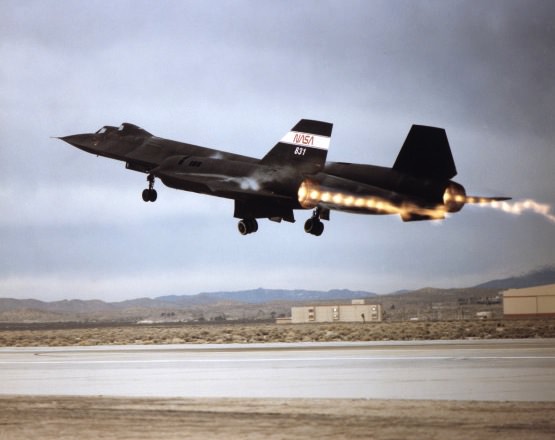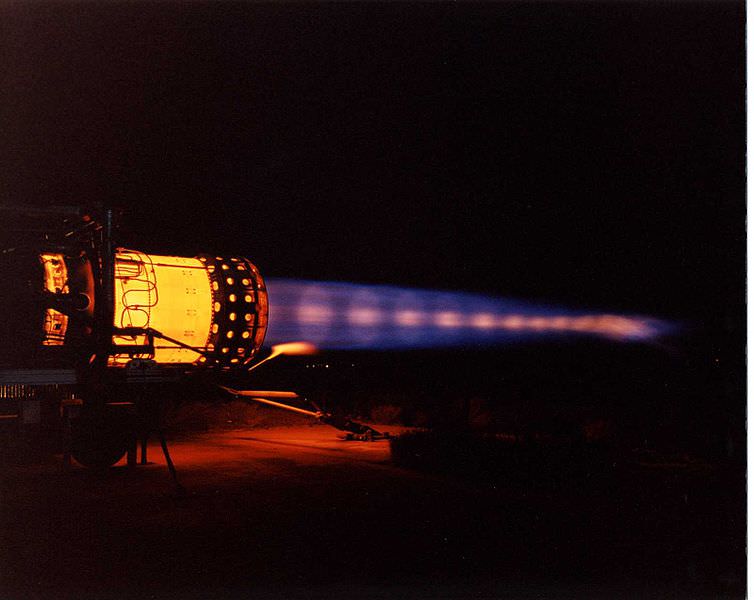[/caption]
I recently reported on Chinese plans to launch Shenzhou-9, and used a stock image of a Long March-2F rocket blasting off the launch pad. Nafin wanted to know what that diamond pattern trailing behind the rocket was, and ivan3man_at_large posted the answer: they’re called shock diamonds.
Shock diamonds? That term had somehow slipped past me, so I thought I’d dig into it some more.
Shock diamonds (alternatively known as “Mach disks”) occur when gas is exiting a nozzle at supersonic speeds, at a different pressure than the outside atmosphere. At sea level, the exhaust pressure might be lower than the thick atmosphere. And then at very high altitudes, the exhaust pressure might be higher than the thin atmosphere.
So these shock diamonds can appear just as a rocket is taking off, or at high altitude when it shifts into supersonic speed.
A classic example is the space shuttle blasting off, but another famous example is when Chuck Yeager’s X-1 rocket plane reached Mach 1.

Let’s take the example of a rocket blasting off. In this case, the exit pressure of the exhaust is lower than the outside atmosphere, and so you get a situation called “overexpansion”. The gas exits the rocket at a lower pressure, and fans outward from the exhaust nozzle in an “expansion fan”. But the outside atmosphere is higher pressure than the exhaust gas, and so compresses it inward. This difference in pressure forces the gas back together at a specific point – the first shock diamond.
(I’ll spare you all the complex fluid dynamics at this point.)
Then the gas compensates and expands again into a new expansion fan, and then it’s forced back together the same distance further along from the rocket at the next shock diamond, and so on and so on. Eventually atmospheric distortion and friction takes over, equalizing the pressure of the exhaust plume with the ambient atmosphere.

Shock diamonds were originally discovered by Ernst Mach, the famous Austrian scientist who did work on fluid dynamics.
One other interesting side note, shock diamonds aren’t just seen in rocket exhausts. They’ve also been seen blasting out of volcanoes and artillery guns
There are two great articles on Mach diamonds if you really want to understand them more deeply. Check out this article from Aerospace Web and this one from the Allstar Network.


This is really very nice posting in this blog. I had really liked the stuff very much.
The information was very cordial. Thanks!
I’ve always wondered about that… Great article!
Nice article. Apart from the fact that Mach wasn’t German 😉
Yikes, I can’t believe I did that… thanks!
“At sea level, the exhaust pressure might be lower than the thick atmosphere”
Isn’t a gas exiting something supposed to have higher pressure than the outside?
A gaseous mass only needs velocity to move to somewhere else. If it were initially stationary, such as inside an air balloon, then a pressure difference would cause it to move.
In this case, the rocket nozzle or jet turbine is designed to give it a particular exit pressure and velocity regardless of the outside conditions.
I had forgotten the physics of the shocks. Thanks!
Two nitpicks: Mach was austrian and the expansion fan denotes the expansion phase so an overexpanded flow starts with a compression fan. (The 1st from Wikipedia and the 2nd from the first linked article.)
Good article, thanks! Guess that includes jet engines…
Shock diamonds are oblique shock waves that are “reflected” in the exhaust. the number of shock diamonds is related to the drop in pressure and hence velocity across the oblique shock wave. they are directly related to the nozzle design (the divergence angle for example) the diamond shocks will go away when the ambient temperature and pressure are optimum for the particular nozzle shape and exhaust velocity.
Neat, it sounds like the gas is bouncing inwards and outwards as a harmonic oscillator. The column is behaving so much like an object with edges, but it’s still composed of bouncing particles.
The glowing little balls of fire in the plumes radiate away heat, reducing the pressure, so radiation must play some role as well as convection in dissipating the oscillations.
Much thanks Fraser!